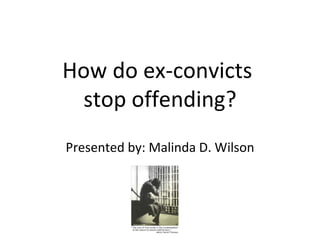Reducing Recidivism Powerpoint
•Descargar como PPT, PDF•
3 recomendaciones•5,435 vistas
An overview of evidence-based therapeutic components that aid in the reduction of the rate of return or recidivism of ex-offenders going back to prison.
Denunciar
Compartir
Denunciar
Compartir

Recomendados
Recomendados
Dr Ranjit Kini and Dr Susan Cooper. First National Personality Disorder Congress, Birmingham, 19-20th November 2009.Therapy for female personality disorder offenders in custody who pose a risk ...

Therapy for female personality disorder offenders in custody who pose a risk ...National Personality Disorder Programme
Más contenido relacionado
La actualidad más candente
La actualidad más candente (20)
Destacado
Dr Ranjit Kini and Dr Susan Cooper. First National Personality Disorder Congress, Birmingham, 19-20th November 2009.Therapy for female personality disorder offenders in custody who pose a risk ...

Therapy for female personality disorder offenders in custody who pose a risk ...National Personality Disorder Programme
Destacado (9)
Therapy for female personality disorder offenders in custody who pose a risk ...

Therapy for female personality disorder offenders in custody who pose a risk ...
Similar a Reducing Recidivism Powerpoint
PART 2 of my collection of clinical notes on the philosophy and practice of psychotherapyAdvanced Methods in Counseling and Psychotherapy PART 2 Revised Feb 04 2018 p...

Advanced Methods in Counseling and Psychotherapy PART 2 Revised Feb 04 2018 p...Demetrios Peratsakis, LPC ACS
Similar a Reducing Recidivism Powerpoint (20)
Health behaviour and health education for family medicine postgraduates

Health behaviour and health education for family medicine postgraduates
RESPOND TO 4 STUDENTS.. There are 2 sets of responses needed totalin.docx

RESPOND TO 4 STUDENTS.. There are 2 sets of responses needed totalin.docx
Motivational Interviewing: Engaging the Stages of Change (Lecture 8).pptx

Motivational Interviewing: Engaging the Stages of Change (Lecture 8).pptx
The Goal of the Therapy Process -revised July 28 2018

The Goal of the Therapy Process -revised July 28 2018
An organization’s vision and how it is communicated and implemente.docx

An organization’s vision and how it is communicated and implemente.docx
Making Recovery Real: Improving Employment Outcomes Using Peer Support Services

Making Recovery Real: Improving Employment Outcomes Using Peer Support Services
Advanced Methods in Counseling and Psychotherapy PART 2 Revised Feb 04 2018 p...

Advanced Methods in Counseling and Psychotherapy PART 2 Revised Feb 04 2018 p...
Reducing Recidivism Powerpoint
- 1. How do ex-convicts stop offending? Presented by: Malinda D. Wilson
- 3. Most want to turn their lives around. Families are a key motivation They want to live with their families, take care of their children, work, and stay out of trouble (Irwin and Austin, 1994; McMurray, 1993: 153). Despite their hopes, many fail (Richards, 1995). The desire to have a changed life presents itself especially during the hot periods: arrest, court appearance, sentencing, incarceration.
- 7. Need to understand: Social Control Theory Crime occurs as a result of weakened bonds to society. Social bonds help restrain deviant impulses. Social bonds to family, school, work, church &positive peers prevent crime. If weak, they can produce criminal behavior. (Crime in the Life Course, 2003)
- 8. What is Interpersonal Therapy It utilizes the best of Cognitive Training in Restructuring Maladaptive Thinking patterns. It takes into consideration, each individuals’ current Stage of Change and level of Social Support It uses Motivational Interviewing Techniques to move the person toward action, including development of stronger social supports. It’s like a laboratory for client’s to experiment new behaviors, strategies, ideas, & ways of communicating
- 10. How Accessing Stage Works: Traditional interventions often assume that individuals are ready for an immediate and permanent behavior change. Not true… Each stage corresponds to an individual's readiness to change, which will vary over time. By matching an intervention to the appropriate stage (or readiness), program designers improve chances of success. Another important and innovative contribution of Stages of Change is its emphasis on maintaining change.
- 12. The Relationship between Stage and both Self-efficacy and Temptation
- 13. Motivational Interviewing Works: MI relies upon the client to identify and mobilize their values and goals to stimulate behavior change . Other approaches have emphasized coercion, persuasion, or the use of external contingencies (e.g., the threatened loss of job or family). Such strategies may have their place in evoking change, but they are quite different in spirit from MI. It is the client's task, not the counselor's, to articulate and resolve his or her ambivalence . Ambivalence takes the form of a conflict between two courses of action (e.g., indulgence versus restraint), each of which has perceived benefits and costs associated with it. Many clients have never had the opportunity of expressing the often confusing, contradictory and uniquely personal elements of this conflict. The counselor's task is to facilitate expression of both sides of the ambivalence impasse, and guide the client toward an acceptable resolution that triggers change. Readiness to change is not a client trait, but a fluctuating product of interpersonal interaction . The therapist is therefore highly attentive and responsive to the client's motivational signs. The therapeutic relationship is more like a partnership or companionship than expert/recipient or teacher/student roles .
- 17. Mentoring Works: Success is more likely when clients can locate, solicit and develop a social support network. Client’s learn how successful people develop accountability structures, healthy friendships and networks This increases practical knowledge, work and career opportunity, interpersonal and spiritual development.